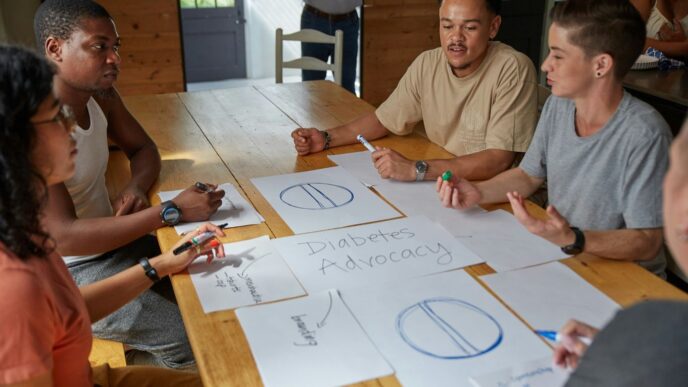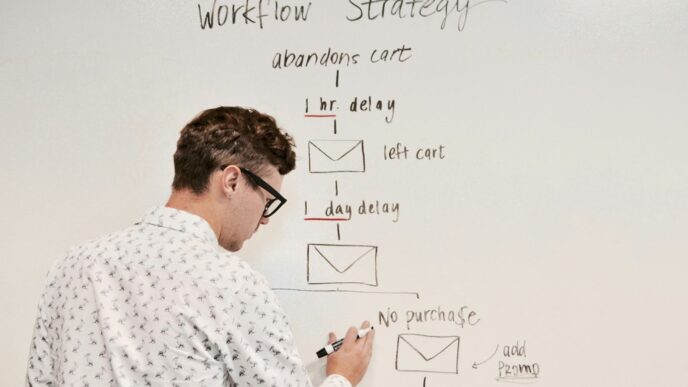Social media isn’t exactly new, but it has totally changed how businesses connect with people. Think about it: platforms like Instagram, X, and TikTok mean brands can chat with customers 24/7. This shift means businesses need pros to handle these online hangouts. While a social media manager might seem like the obvious choice, there’s a special role that’s super important for bringing people together and making them feel connected: the social media community manager. They’re the ones who really bridge the gap, making sure everyone feels heard and part of something.
Key Takeaways
- A social media community manager builds and nurtures online groups around a brand, acting as a key link between the business and its audience.
- Their role goes beyond just posting content; it involves genuine interaction, understanding audience needs, and fostering a sense of belonging.
- Key responsibilities include engaging with members, tailoring content, gathering feedback, and sometimes even planning online events.
- Success in this role requires good communication skills, product knowledge, attention to detail, and the ability to track performance metrics.
- The community manager ensures brand voice consistency and acts as a bridge between different business departments, like product development and customer support.
Understanding the Role of a Social Media Community Manager
What is a Social Media Community Manager?
So, you’re thinking about jumping into the world of social media community management? It’s a pretty interesting gig. Basically, a social media community manager is the person who acts as the main connection between a brand and the people who follow it online. Think of them as the friendly face, or maybe the helpful voice, that people interact with on platforms like Facebook, Instagram, or X. They’re not just posting updates; they’re actively building and looking after a group of people who are interested in what the brand has to offer. It’s about creating a space where people feel comfortable talking to the brand and to each other. This role is all about making genuine connections in the digital space.
The Difference Between a Social Media Manager and a Community Manager
This is where it can get a little confusing, but it’s important to get it right. A social media manager is usually focused on the bigger picture of a brand’s presence online. They’re the ones planning out the content calendar, deciding what gets posted and when, and looking at the overall performance of social media campaigns. They often post as the brand. A community manager, on the other hand, is more about the day-to-day interactions. They’re the ones responding to comments, answering questions in direct messages, and generally being present in the conversations happening around the brand. They tend to post more like an individual representing the brand, rather than the brand itself. It’s like the difference between a director planning a play and an actor performing on stage – both are vital, but their jobs are different.
Here’s a quick breakdown:
| Social Media Manager | Community Manager |
|---|---|
| Posts as the brand | Posts as an individual |
| Creates social media content | Responds to social media content |
| Builds and executes a social media strategy | Builds and executes a community strategy |
| Focuses on monitoring results | Focuses on engagement and interaction |
Key Responsibilities of a Community Manager
What does a community manager actually do all day? Well, it’s a mix of things. A big part of it is just being present and talking to people. This means:
- Replying to comments and messages: This is probably the most visible part of the job. Answering questions, acknowledging feedback, and just generally being responsive.
- Gathering feedback: Community managers are in a prime spot to hear what people are saying about a brand. They collect this information, noting down common questions, complaints, or suggestions.
- Sharing information: They often share helpful resources or links to answer customer questions, acting as a bridge to customer support or other departments.
- Identifying trends: By paying attention to conversations, they can spot what topics are hot or what people are really interested in.
- Helping tailor content: Based on what they’re hearing from the community, they can give input to the social media team on what kind of content might work best.
- Building relationships: This includes interacting with followers, and sometimes even influencers or other key people in the online space.
- Managing during tough times: If something goes wrong, the community manager is often on the front lines, helping to manage the situation online.
Essential Skills for Aspiring Community Managers
So, you’re thinking about jumping into the world of community management? That’s awesome! It’s a pretty cool gig, but it’s not just about posting memes and replying to comments. You actually need a solid set of skills to do it well. Let’s break down what you’ll need.
Look, you don’t need to be a rocket scientist, but you do need to know what you’re talking about. If you’re managing a community for, say, a software company, you should at least understand the basics of their product. How does it work? What problems does it solve? You don’t have to be the lead developer, but you should be able to answer common questions and point people in the right direction. This means being comfortable with technology in general. You’ll be using a bunch of different tools – social media platforms, analytics dashboards, maybe even some specialized community software. Being able to pick up new tech quickly is a big plus. It’s like learning a new video game; some people just get the controls faster than others. If you’re not naturally techy, don’t sweat it. Just be willing to learn and put in the effort during onboarding. Most companies will give you the resources you need to get up to speed.
This one might sound boring, but it’s super important. Think about all the little things that can go wrong. A typo in an important announcement? Missing a key piece of feedback from a member? Scheduling a Q&A session at the wrong time? These aren’t huge disasters, but they add up and can make you look unprofessional. You’ll be juggling a lot: answering messages, planning content, tracking metrics, maybe even managing contracts or proposals. You need to be organized enough to keep all those balls in the air without dropping them. It’s about making sure things run smoothly and that you don’t miss important details that could affect the community or the brand. Mistakes happen, sure, but minimizing them is key to keeping trust and making sure opportunities don’t slip through your fingers.
This is probably the most obvious one, right? You’re going to be talking to a lot of people. This means writing clear emails, crafting engaging posts, and sometimes even speaking at events or hosting online sessions. You need to be able to express yourself well, both in writing and when you speak. It’s not just about talking, though; it’s also about listening. Really listening. You need to understand what people are saying, what their concerns are, and what they’re excited about. Being empathetic and responding thoughtfully makes a huge difference. People can tell when you’re just going through the motions. Authenticity goes a long way here.
What works for one group of people might totally flop with another. You need to get a feel for the community you’re managing. Who are they? What are they interested in? What kind of language do they use? What platforms do they hang out on? Once you understand your audience, you can start creating or curating content that actually speaks to them. This isn’t just about posting updates; it’s about sparking conversations, sharing useful information, and making people feel like they’re part of something. You might be adapting content for different social media channels, writing blog posts, or even just figuring out the best time to post. It’s all about knowing your audience and giving them what they want, when they want it.
Building and Nurturing Online Communities
So, you’ve got the basics down, and now it’s time to actually build something. This is where the magic happens, or at least, where you try to make it happen. Building an online community isn’t just about getting people to show up; it’s about making them want to stay and contribute. It’s like throwing a party – you want people to feel welcome, have fun, and maybe even make new friends.
Developing Community Strategies
Before you even think about posting anything, you need a plan. What’s this community for? Who are you trying to bring together? You can’t just wing it. Think about the goals. Are you trying to get feedback on a product? Build brand loyalty? Or just create a space for people with shared interests to chat? Once you know that, you can start figuring out the best ways to get there. This might involve setting up specific discussion topics, creating guidelines for behavior, and deciding what kind of content will get people talking. It’s all about setting the stage for success.
Fostering a Sense of Belonging
People stick around where they feel like they belong. It’s that simple. As a community manager, your job is to make everyone feel seen and heard. This means acknowledging new members, celebrating milestones, and making sure everyone has a chance to participate. You want people to feel like they’re part of something bigger than just a website or a social media page. Think about creating rituals or traditions within the community, like a weekly Q&A or a monthly challenge. These little things can make a big difference in making people feel connected.
Engaging Authentically with Members
This is probably the most important part. People can spot fake from a mile away. You need to be real. Talk to people like you’re actually talking to another human being, not like you’re reading from a script. Ask questions, share your own thoughts (when appropriate, of course), and show genuine interest in what members have to say. Don’t just wait for problems to pop up; be proactive. Jump into conversations, offer help, and generally be a positive presence. Building trust takes time, and it all starts with being yourself and showing up consistently. If you’re struggling with low engagement, remember that sparking meaningful discussions and recognizing active members can really help turn things around.
Content Creation and Engagement Tactics

Creating content and building engagement on social media isn’t just about posting memes or product photos—it’s way more hands-on than that. If you want the community to stick around, share your stuff, and actually talk to you, you need a plan that goes beyond the basics. Here’s how to make that happen:
Leveraging User-Generated Content
Some of the most interesting and trustworthy content comes straight from your audience. People naturally trust stories and photos from other real users over anything a brand says. Pulling in user reviews, reposting customer photos, or sharing testimonials can do a lot of the talking for you. Here are a few ways to make the most of user-generated content (UGC):
- Run hashtag campaigns—ask your community to post under a certain tag, then share their stuff on your feed.
- Feature a “Fan of the Week” or similar spotlight to celebrate active members.
- Always ask for permission before reposting user content–it builds trust and keeps things respectful.
Tailoring Content to Audience Needs
If you post the same thing everywhere, you’ll quickly see what falls flat. Every platform is different, and so are the people following you on each one. Pay attention to who’s showing up and what they like to see:
- Look at your analytics to spot what times get the most activity—or what topics spark more comments.
- Talk to your followers with polls or open-ended questions to see what they want.
- Adjust the tone and format for each place: for example, short and visual on Instagram, longer thoughts on LinkedIn.
Here’s a simple table of how different content types might perform across top platforms:
| Platform | Short Videos | Polls/Questions | Long Posts |
|---|---|---|---|
| High | Medium | Low | |
| Medium | High | Medium | |
| Low | Medium | High | |
| TikTok | Very High | Low | N/A |
Responding to Comments and Questions
A lot of people forget this part or leave it for hours. If someone takes the time to comment or reach out, you need to show up. Quick, real responses can turn casual followers into loyal fans. Here’s what helps:
- Respond to as many comments or messages as you reasonably can, even if it’s just a thank you.
- Address questions publicly when useful—others might want to know the answer too.
- Admit when you don’t know, but promise to follow up. People like it when you’re honest and human.
Creating content and keeping everyone engaged isn’t rocket science, but it does take heart, consistency, and a little bit of detective work. If you keep your focus on who you’re talking to and make them feel heard, your community will do half the work for you.
Tracking Performance and Demonstrating Value
So, you’ve been busy building this awesome online space, right? Now comes the part where you show everyone why it matters. It’s not just about posting cool stuff; it’s about proving that what you’re doing actually makes a difference. This means keeping an eye on what’s working and what’s not, and then being able to explain it clearly.
Monitoring Key Community Metrics
Think of metrics as your community’s vital signs. You need to know if it’s healthy and growing. While a social media manager might focus on likes and shares, your job as a community manager is a bit different. You’re looking at things like:
- Mentions: How often are people talking about the brand or topic?
- Comments and Direct Messages (DMs): What are people saying? Are they asking questions, sharing ideas, or giving feedback?
- Key Questions and Hot Topics: What are the recurring themes or burning questions within the community? This is gold for understanding your members.
- Sentiment: Are people generally positive, negative, or neutral when they talk about the brand?
It’s also helpful to track how many people are actively participating versus just lurking. A simple table can help organize this:
| Metric | This Week | Last Week | Change |
|---|---|---|---|
| Active Members | 1,250 | 1,180 | +6.8% |
| New Posts | 310 | 295 | +5.1% |
| Comments | 1,500 | 1,420 | +5.6% |
| DMs Received | 450 | 410 | +9.8% |
Identifying Trends and Patterns
Looking at numbers is one thing, but seeing what they mean is another. Are you noticing a spike in questions about a specific product feature? Maybe a particular type of content gets way more discussion going. These trends are super important. They tell you what your community is interested in, what problems they’re facing, and what they love.
For example, if you see a lot of comments asking how to use a certain tool, that’s a clear signal. You might then suggest creating a tutorial or an FAQ post. It’s about connecting the dots between what people are saying and what actions can be taken. This insight helps shape future content and community initiatives, making sure you’re always giving people what they want.
Showing Return on Investment (ROI)
Okay, so you’ve got the numbers and you’ve spotted the trends. Now, how do you show the higher-ups that your work is actually paying off? This is where you connect community activity to business goals. It’s not always a direct line, but it’s definitely there.
- Customer Insights: The feedback you gather can directly inform product development or marketing strategies, saving the company time and money on research.
- Brand Loyalty: A happy, engaged community is more likely to stick around and recommend the brand to others. This can lead to lower customer acquisition costs.
- Problem Solving: By addressing common issues within the community, you reduce the load on customer support teams.
- Content Ideas: The topics and questions that come up can be turned into marketing content, driving traffic and engagement.
Ultimately, a thriving community isn’t just a nice-to-have; it’s a strategic asset that contributes to the bottom line. You need to be able to translate community health into business value. This might mean presenting reports that show how community engagement correlates with sales, or how positive sentiment has improved brand perception.
Planning and Executing Community Events
Okay, so planning and running events for your online community? It’s a big part of the job, and honestly, it can be a lot of fun. It’s not just about posting updates; it’s about creating experiences that bring people together. Think of it as throwing a party, but online. You want everyone to feel welcome, have a good time, and maybe learn something new.
Ideation for Online Events
Coming up with event ideas is where the creativity really kicks in. What does your community care about? What are they talking about? You can brainstorm a bunch of things. Maybe a Q&A session with an expert, a virtual workshop, a contest, or even just a casual hangout. The goal is to create something that genuinely interests your members and aligns with what the brand is trying to do. Don’t be afraid to ask the community what they’d like to see, too. They often have the best ideas! It’s a good way to get them involved right from the start. You can also look at what other communities are doing for inspiration, but always put your own spin on it. The best events feel unique to your community.
Mastering Event Hosting Platforms
Once you have an idea, you need a place to host it. There are tons of platforms out there now, and you’ll need to get comfortable with a few. Think Zoom, Google Meet, Microsoft Teams, or even specialized webinar software. Each has its own quirks. You’ll want to know how to set up the event, manage participants, share screens, and handle any technical hiccups that might pop up. It’s not rocket science, but it does take a bit of practice. Testing everything beforehand is super important. You don’t want to be fumbling with settings when people are already logged in, waiting.
Keeping Attendees Engaged Virtually
This is probably the trickiest part. Getting people to pay attention when they’re sitting in front of their own screens can be tough. You can’t just stand at the front of a room and expect them to listen. You need to actively involve them. Use polls, ask questions in the chat, encourage them to use reactions, and maybe even have breakout rooms for smaller discussions. If it’s a workshop, make sure there are hands-on activities. The more interactive you make it, the better people will stay engaged. It’s also helpful to have a co-host or moderator to help manage the chat and keep things moving. Planning out social media marketing strategies beforehand can also help drive attendance and excitement.
Navigating Challenges in Community Management
Look, being a community manager isn’t always sunshine and rainbows. Sometimes, things get messy, and you’ve got to be ready to handle it. It’s not just about posting cool stuff and getting likes; it’s about dealing with the tough stuff too. You’ll face situations that test your patience and your problem-solving skills.
Managing Communities During Crises
Crises happen. Maybe it’s a product recall, a public relations blunder, or just a really bad day for the brand. When that happens, silence is usually the worst thing you can do. People expect a response, and if they don’t get one, they get angry. Think about that time a big fashion brand just ignored comments about something sensitive – people were furious, and it spilled over everywhere. You need to be quick to acknowledge what’s going on, show some empathy, and let people know you’re working on it. Using tools that let you see all your comments and messages in one place can really help you catch things before they blow up.
Resolving Conflicts and Difficult Situations
Online communities can sometimes feel like a digital playground where arguments pop up out of nowhere. You’ll have members disagreeing, sometimes pretty heatedly, or maybe someone is just being a jerk. Your job is to step in, stay calm, and try to de-escalate things. This often means listening to both sides, reminding people of the community rules, and sometimes having to have a private chat with someone who’s crossing the line. It’s about keeping the space safe and welcoming for everyone, even when people are upset.
Staying Persistent Amidst Setbacks
Not every post will be a hit, not every event will be packed, and you’ll probably get a lot of rejections when you’re starting out. It’s easy to get discouraged. You might pour your heart into a strategy, and it just doesn’t work. Or maybe you’re trying to grow a community, and it feels like you’re stuck at the same numbers for weeks. The key here is to not give up. Learn from what didn’t work, tweak your approach, and keep trying. Persistence is a big part of this job. You have to believe in the value of the community and keep showing up, even when it feels like you’re not making progress.
Wrapping It Up
So, you’ve learned a lot about being a community manager. It’s not just about posting stuff online; it’s about really connecting with people. You’re the bridge between a brand and its fans, making sure everyone feels heard and valued. It takes work, sure, but seeing a community grow and thrive because of your efforts? That’s pretty rewarding. Keep learning, keep adapting, and remember that building genuine relationships is what this job is all about. Good luck out there!
Frequently Asked Questions
What exactly does a social media community manager do?
A social media community manager is like the friendly face of a brand online. They help build and take care of groups of people who like a brand, making sure everyone feels welcome and has a good time. They chat with people, answer questions, and help create a fun space for fans to connect.
Is being a community manager different from being a social media manager?
Yes, they are different! A social media manager usually focuses on creating and sharing posts to reach many people. A community manager, on the other hand, focuses on talking with the people who already like the brand, building relationships, and making sure the community feels connected.
What are the most important skills for someone wanting to be a community manager?
You need to be a good communicator and listener. It also helps to be organized, pay attention to details, and really understand the product or brand you’re working with. Being creative and knowing how to use social media platforms well is also super important.
How do you create a sense of belonging in an online group?
You can make people feel like they belong by being friendly and welcoming. Encourage members to talk to each other, share their own ideas, and celebrate their contributions. Making sure everyone feels heard and respected is key.
What’s the best way to handle negative comments or arguments in a community?
When negative comments pop up, it’s important to stay calm and polite. Try to understand the person’s issue and respond respectfully. Sometimes, you might need to move the conversation to a private message to sort things out. Setting clear rules for the community also helps prevent problems.
How can you tell if a community is doing well?
You can tell a community is doing well by looking at how much people are talking and interacting. Are members asking questions and helping each other? Are they sharing positive feedback? Tracking things like how many people are joining and how active they are can also show success.














